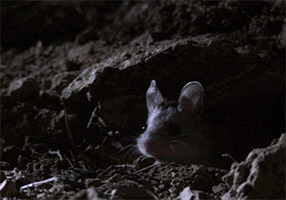-
Welcome to rpgcodex.net, a site dedicated to discussing computer based role-playing games in a free and open fashion. We're less strict than other forums, but please refer to the rules.
"This message is awaiting moderator approval": All new users must pass through our moderation queue before they will be able to post normally. Until your account has "passed" your posts will only be visible to yourself (and moderators) until they are approved. Give us a week to get around to approving / deleting / ignoring your mundane opinion on crap before hassling us about it. Once you have passed the moderation period (think of it as a test), you will be able to post normally, just like all the other retards.
You are using an out of date browser. It may not display this or other websites correctly.
You should upgrade or use an alternative browser.
You should upgrade or use an alternative browser.
KickStarter Chaos Reborn - remake of Julian Gollop classic
- Thread starter LESS T_T
- Start date
Trash
Pointing and laughing.
Glad to see that some things can turn out right after all. Let's see how well a Spectrum game translates to modern gaming.
- Joined
- Jan 28, 2011
- Messages
- 100,645


















They still have to solve the advantage for the starter, I think. Other than that, it's a perfectly fun game.
The game has come a long way, visually looks completely different from the early builds.
- Joined
- Jan 28, 2011
- Messages
- 100,645















Steam page: http://store.steampowered.com/app/319050/



There will be a single-player campaign in the final product (hopefully).
- Joined
- Sep 25, 2012
- Messages
- 30,436








Waiting for this, really.There will be a single-player campaign in the final product (hopefully).
tuluse
Arcane
- Joined
- Jul 20, 2008
- Messages
- 11,400





LESS T_T
Arcane
- Joined
- Oct 5, 2012
- Messages
- 13,582
![The Year of Incline [2014] Codex 2014](/forums/smiles/campaign_tags/campaign_incline2014.png)
According to the Kickstarter update, the game will cost $19.99 with 15% discount in the lauch week. The pricing will remain the same between early access and final release.
- Joined
- Jan 28, 2011
- Messages
- 100,645















Interview: X-COM’s Julian Gollop On Remaking Chaos
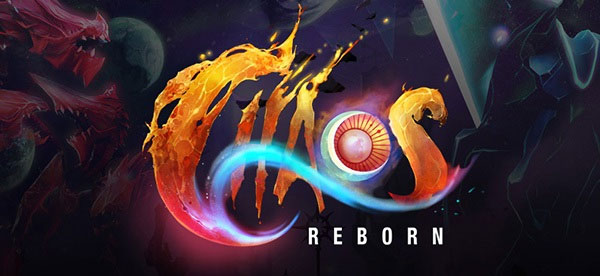
After some time out of sight, X-COM creator Julian Gollop returned earlier this year, with asuccessful Kickstarter for a remake of/spiritual sequel to his beloved Spectrum strategy game, Chaos. (That being the one where wizards battle each other to death, with the help of various summoned beasties). An early, multiplayer-only version of Chaos Reborn takes to Steam Early Access today, so ahead of that I had a chat with the Laser Squad dev about how it all happened, what’s changed, how much of a purist he is about his old work, his thoughts on Kickstarter and what’s planned for the forthcoming singleplayer mode.
RPS: We’re talking on the eve of the Early Access launch – what’s the state of things there?
Julian Gollop: We’re getting ready for launch, we’re doing some final testing and some polishing, we’re getting some sound effects polished up and some visual effects put in, interface’s glitches cleaned up. It’s looking good actually, I think the game is actually quite well polished for its current state and I’m very happy with it.
RPS: Has it been a desperate sprint to this finish line or have you been able to have the luxury of saying, ‘oh, we’ll just come up with a date when we know we’re happy’?
Julian Gollop: It’s been quite tough, yes, because we’ve had a lot to get ready for this launch. We wanted to make sure that the experience was going to be a good one for the players. Actually this last week has been mostly polishing and fixing bugs so it hasn’t been too strenuous. Yeah, it’s been good.
RPS: It’s surprisingly glossy, when I loaded it up the other day. It’s sort of the same game as the thing I played six months ago or whenever it was but it’s really really glossy, it’s got this big epic music and all the graphics in it. There’s a real shift in thinking.
Julian Gollop: Quite different, yes, it is (laughs). There’s a lot more detail in the graphics, the environments, the sound and so on. But I think it’s worked out quite well. We still have very distinctive coloured creatures with quite distinctive designs and I still think it’s a bit reminiscent of the original Chaos but it’s quite a long way from it in some ways as well. The core gameplay is still there, it’s pretty solidly Chaos, and I guess that the main thing that we’ve added maybe since you’ve last played it is the staff system and mana system.
You’ve got a selection of staffs of various types, staff or law, staff of chaos, staff of shooters and so on which effect your spell deck. So if you’ve got a staff of law you’ll tend to have more law spells in your deck, but the staffs can be used to boost your spells. If the spell matches the types, then the boost will be double, and you use mana points to boost them, so you get mana points from killing creatures and collecting mana sprites, which are these little glowy purple things that you see in the map.
This becomes another tactical thing to consider because you need to think about how to get the mana sprites and how to use them. So you can use a mana sprite to boost the casting chance of a spell, this can obviously reduce a lot of the risk in the spell casting aspect of the game. When you really need it, it can be very very useful.
The other thing is that if you build up enough mana points, your staff has a special mega-spell, depending on the type of staff, and this could be like a mega-bolt, which is a triple magic bolt with extended range and power, or it could be summon an elf squad where you’ve got a squad of three elves summoned in one go, and these mega spells can also be pretty useful. So it’s given you some more tactical considerations I think, and it also gives you the opportunity to perhaps have slightly different play styles, so if you want to play things more deterministically, then you can carefully decide which spells you really want to bring in, and get mana points to boost those.
The other way to get mana points, which is also an interesting feature, is that you can burn a spell card and that will get you ten mana points, at least for your first one burnt, although that does decline so for the second one burnt it will go down to 9 mana points and the third one will get you 8 and so on. So you could say, well, that other player has got a staff of chaos, so he might be likely to be a bit more biased to chaos spells. I might have a staff of neutrality but I also might have a law shift spell, so I can use that to move the balance of law towards law to avoid my opponent getting the benefit from the chaos shift. Or I could burn the law shift spell for ten mana points and try and boost one of my, if I’ve got a big creature like a giant, I can increase the casting chance from 40 to 60.
RPS: Yeah, I’ve had a quick play with that system. It’s a big psychological shift, the whole concept of burning cards. I was doing it in collectible card game way with the knowledge that it would hopefully put something more appropriate into my deck.
Julian Gollop: Yes, it can be useful from that point of view…
RPS: But the traditional Chaos thing is that even if a card is to some degree not very useful to you because the casting chance is so low, you could at least cast it as illusion, so the idea of getting rid of something completely I struggled with.
Julian Gollop: Yes, it does have another dimension in now. Some players are more keen on burning cards and some are more keen on burning certain types of cards as well. Again it can depend on your situation. If you’re really in a tight spot and you really need for example that Tanglevine spell to be reliably cast, to protect your wizard from a likely death, then you probably do really need to burn some cards to boost its casting chance to make sure it’s summoned with 100%. So that’s the kind of situation where you’d probably be quite likely to burn some cards.
RPS: So it’s gone in, presumably, to add extra levels of strategy rather than in a sort of ‘Well, it’s the 2014 version so it needs something new.’
Julian Gollop: Well we’ve put it in partly to add some flavours to the staffs, to the types of equipment you’ve got, so they need some kind of abilities which you can untap. But because they’re quite powerful they’re not something you can use straight away. So your staffs need mana points to be useful. And of course ultimately you’ve got those mega-spells which you can unlock with lots of mana points, and that can also be something you can aim for on the long term in a game. So it adds more distinctive flavours to the different wizards with different sets of equipment – in this case we’ve only got the staffs – it does bring some more considerations to the game, it’s true.
It seems to have gone down quite well with the players. We have for example introduced some other game mechanics which I took out because they weren’t quite so good, like for example we had a retreating mechanic where if you attacked a creature he might retreat rather than be killed. But it didn’t really add too much to the game, and if anything it made the purity of the game system a bit more complicated because now you have some very clear feedback as to what your chances are of doing something. So if it says you’ve got a 60% chance to kill a goblin with your elephant, then it’s 60%, you don’t have to take into consideration all kinds of other stuff.
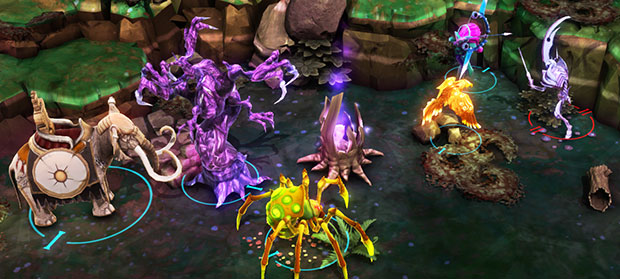
RPS: It’s quite absolute at the moment.
Julian Gollop: Yeah, so the retreat mechanic brought complications rather than adding anything interesting and we had another piece of equipment called the wizard hats which I’ve removed for now, until we find a better way to implement those. More recently we put these mana sprites, which are these little things that you can pick up with your wizard only, which get you 25 mana points, so that has introduced a little strategic objective to the players when they start the game.
They can be aggressive and try and go for those mana sprites but take some risks, maybe unnecessary risks, or they can use some spells to try and secure mana sprites, for example tanglevine becomes more useful because you can create a wall around a mana sprite before you reach it so that you can get it safely, which I’ve used quite a few times. It also means that turtling or hiding in a corner somewhere is a less reliably good strategy to take in many situations. It still can be valid of course.
RPS: But the other guy’s amping up while you do that…
Julian Gollop: Yeah, so if you just run away, you’re going to let him get all the mana sprites, and then he’s going to boost all his spells or get his mega-spells, so you either have to get the mana sprites yourself or in some way try and deny the enemy players from getting mana sprites. So again, there’s more to consider there in terms of the manoeuvring around the maps. That’s been pretty popular with the players.
We tested all this stuff with our player community and we’ve gone through 21 versions since the end of the kickstarter, 21 updates. It’s quite a lot and many of those have been focused on gameplay mechanics and balancing stats and everything. A few more recent ones have been a bit more focused on the interface, for example recently we’ve put this card, spelldeck paradigm, into the game, where you’re drawing a hand of cards from a spelldeck and casting them onto the board.
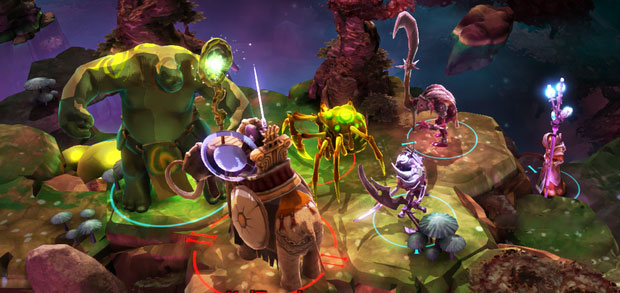
RPS: Which is quite in vogue at the moment.
Julian Gollop: It is, yeah. Although I wouldn’t say our game is in any way a card game as such, but it is nice to see the spells on the cards in front of you and get an instant view of what you’ve got.
RPS: Yeah, you can fiddle with them and look at them while you’re waiting for the other player’s turn. A tactile quality.
Julian Gollop: Yeah, that’s worked out quite well, we made a few improvements on the version that you’ve got with that, but fundamentally we think that’s worked quite well. Of course more recently we spent more time on the graphics environments and sound and music and so on, so that’s been a bit more of a recent focus. And we’ve got 12 animated creatures in the game at the moment; we have been experimenting with a lot more during the course of the last few months, we picked 12 to get a more distinctive mix of abilities and types and so on.
That’s sort of interesting, adding more creatures becomes more difficult because each creature we add has still got to add something distinctive to the game, rather than just be like a grunt plus one, or another version of an elephant. We’re going to be focusing more on creature abilities and what makes them distinctive, rather than just putting loads and loads of different creatures in there which are just small variations on a theme.
RPS: To what extent are you still in touch with your thinking at the time for the original as to why each creature went in; is the same motivation still there or are you now questioning each one and coming up with a new purpose?
Julian Gollop: We’re being a bit more questioning about what does a creature add in terms of something a bit unique; what will it bring that’s reasonably distinctive from the other creatures. So the original Chaos had quite a lot of creatures but many of them were just slightly more powerful variations of each other, even though there were some importantly distinct abilities such as being undead, or flying, or having ranged attacks.
Ultimately there wasn’t a huge distinction between some of them, and with Chaos Reborn, more creatures have some more distinctive abilities. We’ve got for example the giant spider casts a web, which will trap enemy creatures or wizards, and we’ve given an ability to the elephant, who is not an especially strong combat creature, he’s a very defensive and reliable mount, but he’s got this bulldoze ability which makes him very good at clearing away the shadow trees, the tanglevines or the gooey blobs; he’s very effective at destroying those.
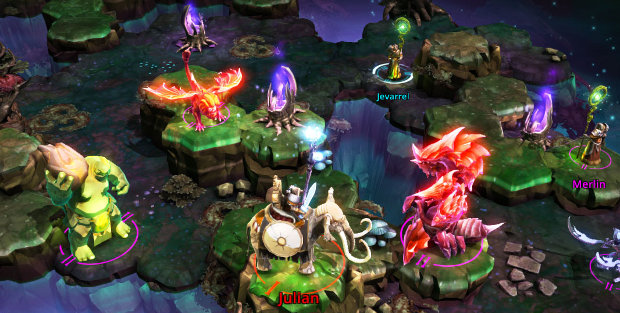
RPS: How much of a purist are you about your former work?
Julian Gollop: If it needs it, I’m happy to rip it up, but I think the original principle I had, which was to stick to the core, simple mechanics of the original, is still there. A very obvious thing of course is the fact that creatures don’t have hit points, you either kill them or they survive. This is a very distinctive feature of Chaos which we’re certainly going to keep.
Another very interesting change which might not seem that drastic but actually does have quite an impact is that in the original Chaos, there was a very strict sequence of what you could do with creatures. You could move with a creature and then you attack with it, that is it. But in Chaos Reborn you can attack and then move, which may not sound like a big difference but actually it can make a very interesting difference in many situations, and the wizard, because in the original Chaos you had this preliminary spell-casting phase, as well which was a separate phase, which we’ve done away with.
Now your wizard can do three things in any order in a turn: he can move, cast a spell and attack, or he can attack, cast a spell, and move, or he can cast a spell, move and then attack. That can also make for some interesting decisions that you might need to take into account.
RPS: I was noticing it with the Engaged, or entangled system [if you creature begins a turn adjacent to an enemy, it remains locked in combat with it until that enemy is removed], you can attack something, then you can move your guy over to a different enemy just to tie it up.
Julian Gollop: That’s right, and it gives you a chance to escape after you’ve killed your enemy, which is good (laughs). The wizards have got this interesting added level of flexibility to what they can do each turn, and you need to think a little bit more about what order you do things in, in many situations in fact. That’s gone done quite well with the players, so we’re quite happy with that.
RPS: How much are the backers calling the shots?
Julian Gollop: Well, of course they’re coming up with lots of ideas, some which are probably not that useful. It’s very clear that if we implement something which doesn’t work well, it becomes pretty obvious very quickly. In terms of adding new things to the game, it’s a bit more vague, because they come up with so many suggestions, most of which are far too complicated, so when you’re adding stuff to the games system, this is actually a much more careful decision to make.
If you’ve got something in the game system which is clearly not working, that’s a little bit easier. My usual response to that is just to rip it out completely. In some cases you might be able to tinker with something to get it to work better, but quite often it’s probably just something you need to rip out. So the process, my design practice, is that you add things, you add some mechanics, changes, they do add complexity to the game, and quite often you end up then simplifying again. It can be a bit brutal, only the best working systems will remain in the game.
RPS: I suppose there’s this constant balance between stuff that makes it better and stuff that stops it feeling like Chaos.
Julian Gollop: Yes, and also you’ve got to bear in mind the complexity issue as well, if it’s making it too complex without that much benefit, then it can be a problem. For example, I was pretty worried about the mana sprite system because it does add a significant level of complexity, but actually you can still play Chaos pretty much in the old way if you want to, it doesn’t actually alter the fundamentals. So you can go about casting spells without worrying about mana at least in the initial stages.
RPS: You’d need to have a pact that the other player was going to do the same.
Julian Gollop: Yeah, it’s not something that really alters the fundamentals of Chaos, and it’s one of the changes that has gone down quite well. It is more advanced than Chaos, but I’m happy to add some systems that are going to give the game some more tactical depth.
RPS: Yeah, it felt like there was a need for games to be more dramatic as they approached their close; previously many games could end in a time-out, which was just a bit anti-climatic, but now you have these crazy spells in and mega-spells.
Julian Gollop: There’s a little bit more encouragement to be aggressive I think in Chaos Reborn than Chaos, and having these mana sprites distributed on the map which can only be collected by wizards is one factor there. Another factor, by the way, which is perhaps a little bit more subtle but can be quite significant in certain situations, is that you’ve got this mana surge effect. If a wizard kills a creature or another wizard at range one, right next to him, you get double mana from that kill.
Of course it’s risky trying to do that. The best way to do that is to be riding a mount, because the mount gives you that level of protection, and you probably need to make sure that your wizard is reasonably well protected, say with a magic shield, having a magic sword helps in this case as it can be very effective in close combat, and also having these combat spells like triple magic attacks, can be very useful. So there’s that little bonus there which you have to take into account if you’re trying to get mana. There’s a bit more encouragement to be aggressive in the Chaos Reborn than the original Chaos – turtling is not really such a good option.
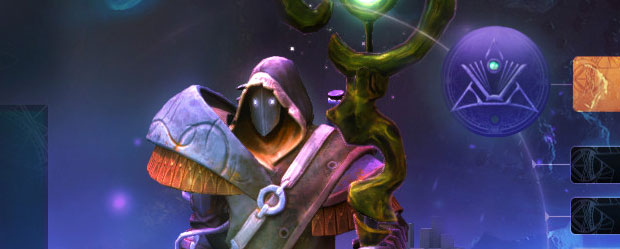
RPS: I guess you’ve got character builds coming through now, you’re trying to build your deck and your wizard to be a certain style, much more than you’re just going to roll with whatever’s in front of you each time.
Julian Gollop: That’s going to come in soon. The configuration of your wizard in terms of his spell deck, his staff, and also body gear, is not in the first Steam release but will be coming soon. We have experimented with different types of body gear which gives you different basic stats, different attack/defence magic power values, and so on. The levelling up of equipment will also be coming in at some point,, but in other cases interesting dynamics, shifts in the way that you play the game. The element of construction for your wizards and configuration, is going to be a big thing. That’s going to give us a lot more balance issues to consider of course.
RPS: Are you going to have a pure mode for people who just can’t hack all these changes?
Julian Gollop: Yes there is, there’s going to be a classic Chaos mode, which will have the random spells and random maps and is just going to be straightforward battles.
RPS: To what extent does what you’ve got, or what you’ve got coming in the very near future, resemble what you expected to have when you wrote that first Kickstarter page?
Julian Gollop: So far it’s pretty close to my vision there I think. I can’t see that there’s anything that’s particularly diverged from that original vision in the Kickstarter, no. There’s obviously one or two mechanics which we’ve been playing around with, but nothing fundamental. The original Kickstarter vision was to keep the core mechanics of Chaos, still relatively simple quick-playing accessible game, this was all very fundamental. And that’s always going to be the heart of the game.
Around this we were going to construct an RPG system, which uses a lot of procedural generation in terms of it’s generating these realms which you explore. As you explore the map you encounter enemy wizards and you go into battles with them and the environments are based on the environments in the realm level. So there’s going to be nine different environment types. That’s a major additional layer to the whole Chaos experience, and that will have some co-op elements to it as well. So one of the things which I noticed people liked a lot about the original Chaos is playing multi-player games with other human players but also with a number of AI players.
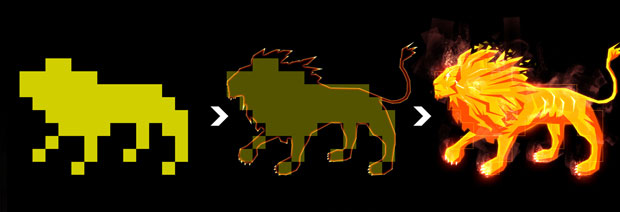
RPS: Yeah, and a lot of people still do that with games like Civ. These days there isn’t officially a co-op mode but it just seems to be how some humans like to approach these things.
Julian Gollop: Yeah, it’s very popular. I can understand it so we’re going to make a bit more of that in terms of our official mode. So the realm mode you can play co-operatively with a friend, you’ll also be able to play co-op battles versus AI so if you had a, say, two versus two match you can play with a human teammate against two AI. Or you can set up how you like and have a free-for-all game with any combination of human and AI players – three human, three AI, that kind of thing. That was a really interesting feature of the original Chaos that we want to also make a bit more of in Chaos Reborn.
RPS: Is the levelling up and loot acquisition you’re going to do in the single player going to cross over in the multi-player or will it be two different sets?
Julian Gollop: That’s a good question. The conventional way of doing things is to keep them separate, but there will be some crossover in some of the multiplayer modes, yes. So in the standard multiplayer mode you’ll be able to use your equipment that you get from the single player system and level up. The matching system will be based on your character level and equipment level compared with other players. But there will also be some more pure competitive multi-player modes.
One of the modes we’ve got planned is one where every player gets the same selection of spells, although it’s a random selection, and then from that you have to construct your deck. You have to discard one third of those to build your deck, and then you go into battle. And also, you might have a choice of three different staffs to take in as well. Every player gets the same choice, but you have to whittle it down and then go into battle with what you’ve chosen. You’ll see some interesting effects there. So that’s one of the multi-player competitive modes that we’re going to have rankings on, which I guess is a more pure gameplay mode, because it doesn’t have any RPG element to it, but it still has this small element of constructed play to it.
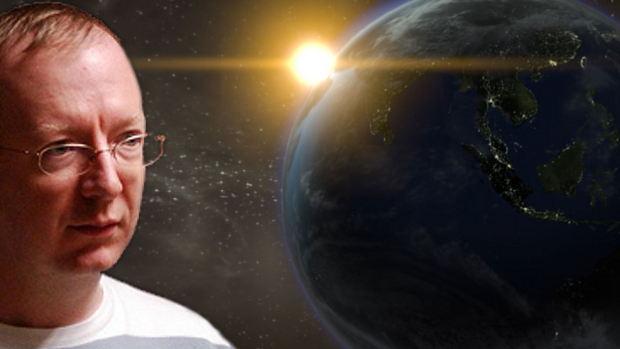
RPS: Probably quite a good way to learn as well, if you see someone using the same cards as you in ways you hadn’t thought of.
Julian Gollop: Yeah, so it’s about trying to figure out what might make good combinations of cards or what your general strategy might be. You might have the strategy of going for law or going for chaos, or you might have a strategy which combines magic weapons with some good mounted creatures, that kind of stuff. That will be a pretty interesting mode when we put it in.
RPS: Kickstarter and Early Access just didn’t exist for the bulk of your career, you’re someone who has been in the business of shipping games, and how natural has it been to adapt to this new way? Was it scary at all?
Julian Gollop: Yes, it was a bit scary. The biggest problem with Kickstarter is the fact that you are making promises based on not very much, and this really is a very difficult issue with a lot of Kickstarter campaigns. As Peter Molyneux recently commented, he doesn’t like Kickstarter because he’s too tempted to promise stuff which he might not be able to deliver.
RPS: In his case he’d find some way to do that regardless I think.
Julian Gollop: So that does make it very very difficult. So I think you need to be pretty sure, especially on the game design side. Before I started my Kickstarter I had been working on the game nearly a year actually, both design and prototyping, which sounds quite long but I was still worried that the state of the design and the game at the time of the Kickstarter, I worried was it too immature, did we have enough there to really guarantee what we can do? Were all the design ideas that we had in the Kickstarter valid, would they work? Because you never know for sure until you try and implement it. There’s always some element of risk. But I think I’m still pretty clear on the vision, we haven’t deviated from that vision of the original Kickstarter and I’m quite happy the direction we’re going in is still the right one.
RPS: Certainly the build I played yesterday, it has the same feel as the one I played last year.
Julian Gollop: Yeah. We still have some interesting things which are more experimental, such as our social ranks system. Although these features are not hideously complex in themselves, they might have some dynamics which we can’t foresee and we’re going to need to test. I think those might be the more exciting aspects of the game once we get those up and running.
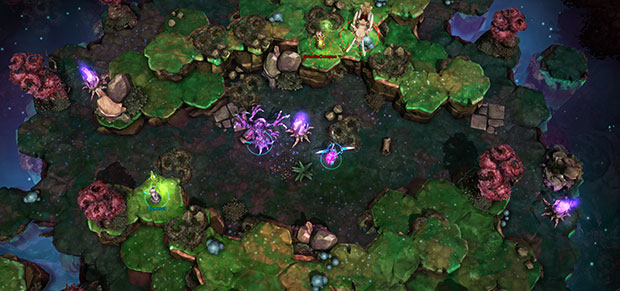
RPS: What sort of aspects of it are you talking about there?
Julian Gollop: Specifically, we’ve got this feudal system where you can progress, again it’s entirely up to the player whether they want to go down this route by the way, it’s not something which is compulsory. They can become a wizard lord and then a wizard king, then a demi-god, and finally a god. Each of those levels introduces a new role for you to play as a wizard, from the simple one which is wizard lord, where your wizard can be configured to be a defender of a region and a realm that other players will encounter, and as a wizard king you can be a ruler of a realm and there you have the choice of just going with the random realm generator to rule over a realm, or you’ve got some realm construction tools, so you can design your own realm for other players to adventure in. And you can populate it with random wizard lords or you can populate it with other wizard lord players that you know, and can take part in your realm.
RPS: So this is a discrete mode?
Julian Gollop: Sort of. In the single player RPG mode the players are going off and exploring all these realms, and most of them are probably procedurally generated, but some will be created by these player kings, and they get ratings based on how interesting players think their realm is. It’s not amazingly complicated, it’s a simple map editor and you can set positions for various features like citadels and towns and stuff, and you can set some simple encounters for players to interact with. It’s not going to be amazingly complicated but it does add an element of customisation, personalisation, to these realms that these players can do.
If you become a demi-god then you have to manage a guild of players. The guild system again is not amazingly complex but players can join your guild, and you have a guild ranking, and you can trade items with the other guild members. That’s basically it. Then if you progress to becoming a god, you’ll effectively have your own guild of demi-gods to manage in this case, and you have a few tools at your disposal to dispense blessings and favours to your followers. The more followers you’ve got, the more blessings you can distribute, and you create these shrines which can be placed directly in maps, which can benefit your followers when they come across them. So that’s the social rank system.
RPS: In some of these tiers you could get them in the pledges, couldn’t you?
Julian Gollop: Yes, so basically if you’ve pledged at a god level you’ll start as a god, even though your wisdom level will still be at level one – you won’t be very powerful. You can start using the god role systems, so you can start managing your demi gods, you can start trying to attract demi gods to follow you and then you can start choosing which of the blessings and shrines you want to create and distribute.
There’s no requirement for players to even take part in any of this system if they don’t want to. You can progress your wizard and his wizard level and if you want to focus on multi-player and multi-player rankings then you can focus on that if you want to. There’s no absolute obligation to take part in this system, but there are some interesting gameplay elements there if you do take part, so there are some opportunities to get rankings in each of these levels, and in terms of progressing your wizard level, you might be able to get more help from other players if you take part in the guild rather than trying to go it alone.
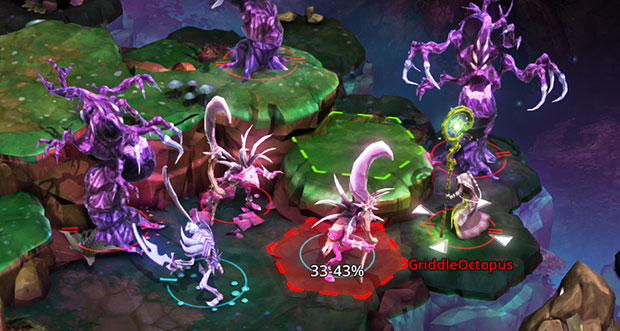
RPS: Almost sounds like an MMO to some degree?
Julian Gollop: Yes, it is sort of, yes.
RPS: Kind of not a label anybody wants to put on their game these days.
Julian Gollop: Yeah, trouble is if you call it an MMO, that has very specific connotations which don’t quite work. It’s a bit more like Clash of Clans in the sense that you take part in, say, a guild, you still might be playing by yourself most of the time against AI, for example in the RPG system. But it’s not like a classic MMO in any sense. Although I don’t really like the description, the game has these social features which are additional to the core game system.
Chaos Reborn is out on Early Access now. Tomorrow on RPS: why Julian Gollop seemed to disappear for so long, his thoughts on the various X-COM comebacks and whether there’s still a chance he’ll attempt one himself.
Disclaimer: I backed Chaos Reborn on Kickstarter, because I wanted to play it.



Both RPG Feudal System AND Classic Mode competition? This just sounds too awesome to be true. I just love this game

Edit:
Thank you, Mr. Gollop

Edit:
Dear Chaos Reborn backer,
Here is your Steam CD key for activating your game and your specific reward level.
[redacted]
You will need to have a Steam account (please visit the Steam website to set one up). In order to activate your game with the CD key follow the instructions here.
Once the game is activated, install it using the Steam client and run the game. You will be asked to link your Steam account to your Chaos Reborn account.
In order to activate your reward tier (Forgemaster, Wizard Lord, Wizard King, Demigod or God) you need to login and then press the yellow ‘BACKER UPGRADES’ button on the top right of the wizard screen. Then press the white button at the bottom of the screen labelled ‘ACTIVATE KICKSTARTER BACKER UPGRADE’. You should then enter your Steam key to activate your special reward tier. You will have the option of upgrading your rank further up to Wizard King level, but no higher, from within the game.
Thank you for your support, and good luck with your games.
Julian Gollop
CEO Snapshot Games Inc.
Thank you, Mr. Gollop
Last edited:



I hope they fix the "whoever starts wins" bug.
- Joined
- Jan 28, 2011
- Messages
- 100,645















Released on Early Access.
- Joined
- Jan 28, 2011
- Messages
- 100,645















More interview:
Whatever Happened To X-COM’s Julian Gollop?

Well, he eventually rebooted and remade war of wizards Spectrum classic Chaos Reborn, which I’ve had a lot of fun with over the last few days, and which took to Steam Early Access yesterday. You can read more about that here. But what happened to the co-creator of X-COM, Laser Squad, Magic and Mayhem, Rebelstar and more over the last ten years or so? While so many long-standing developers have seen their stars rise and rise, Julian Gollop seemed to fall out of sight. In this concluding part of my big interview with him, we talk about where he’s been, why he turned to Kickstarter for his comeback, how he was doing Early Access long before it ever existed, his thoughts on latter-day X-COMlikes such as Xenonauts, Invisible Inc and Mordheim, and the pressing question of whether we’ll ever see a new X-COM or Laser Squad=style game with him at the helm.
RPS: How confident were you that the Chaos Reborn Kickstarter was going to work out, both ahead of it and while it was going on?
Julian Gollop: Well I had no idea. It’s a shot in the dark. You just don’t know. I was very worried that I was asking for too much money, that we wouldn’t meet the target, that people had become too jaded and too cynical. But the response was very good, so that was encouraging.
RPS: You definitely launched at a time when it was a lot less certain than it was.
Julian Gollop: If I’d launched it just a year previously it might have made a big difference in terms of the amount that could be raised. It’s difficult to say but the biggest concern is how sustainable both the combination of Kickstarter and Early Access is for small indie developers.

RPS: How much of a necessity was Early Access for you?
Julian Gollop: Well, at some point we had to do it, yes. Basically we had up to this point a publicly available webplayer-based version of the game, but we need to start making it more closed. That is, our existing Kickstarter backers and people who buy the basic package on Steam will be able to take part in the process of developing the game. And obviously we need to start integrating with Steam’s systems sooner rather than later because it’s a pretty fundamental distribution system. Hopefully we’ll be on other channels as well at some point in the near future. The main advantage of Steam is the exposure it can get to a much wider community of players that you just can’t reach anywhere else, even though Steam’s changed their rules, their discovery system, it’s still the case that it’s really the place to go to for PC games, especially for small to indie-sized developers.
RPS: Were you fairly well-versed in all these new development systems – Kickstarter and Early Access – when you set out to do Chaos, or did you have to have a crash-course outside of the studio system?
Julian Gollop: Well, there was a certainly a lot to learn, mostly in marketing and getting your game noticed I think. That’s the most difficult bit. I’ve done some things similar to Early Access before when we did Laser Squad Nemesis, but this is going back a long way. Back in 2001, when we started on Laser Squad Nemesis [which our Kieron ran a Making Of on years ago here], we had the idea to release the game after a year as a development, no matter how far we’d got with our original plan.
So for example, we’d always planned to put in these three different factions, but we launched it with two factions in February 2002 with the view to continuing to add stuff to the game, which we did. So it was a bit like an Early Access launch what we did with Laser Squad, because we said to players ‘we’ve got this plan, these are the features we want to put in, but we’re going to start selling it before they’re all there.’ That actually worked out quite well with Laser Squad Nemesis but the thing we lacked was any really big reach or distribution system.

RPS: I guess people were patching in the new stuff with magazine cover discs, which is a very strange thing to think about these days.
Julian Gollop: Yeah, it was still very much magazine focused, cover discs for PC, and PC games were not in a brilliant place at that point for indie developers. It was only at that point casual games on the PC were becoming very big and one of the main game-changers there was Bejewelled, but that came out in 2001. It was about the same time we were doing Laser Squad Nemesis and I remember having conversations with Jason Kapalka from PopCap about doing something using their PopCap development system, but it wasn’t really sophisticated enough for us to do something similar to Laser Squad Nemesis, unfortunately.
RPS: The PopCap then were nothing like the PopCap now I imagine.
Julian Gollop: No, but that was the time in PC games when the casual games side was becoming big, but online distribution of hardcore PC games just didn’t exist really.
RPS: Yeah, it was just something you’d see in Tesco mostly, they’d have a little games section with stuff like Bejewelled and maybe a copy of Theme Hospital.
Julian Gollop: But still, in a way that’s kind of what we did with Laser Squad Nemesis, it was like our own Early Access development, and so that’s quite familiar with Chaos Reborn here that we got a certain vision for the game that we want to implement and we’re implementing it feature by feature, step by step, with the involvement of our players and it’s a really nice way of developing games.

RPS: And basically you’re ahead of the curve in releasing unfinished games. Around that time I guess, and really up until Firaxis’s XCOM game came out, there was this sense that you were somehow elusive, you’d disappeared. Was there any truth to this or was it just journalists being lazy?
Julian Gollop: Well I guess, after Laser Squad Nemesis, we kept maintaining it for a few years actually, I think up until three years we were working on it still. But it wasn’t really gaining many new players, so it was getting a bit stagnant in the sense that we didn’t have enough money to really make a big step forward with it. We then did a game for the GBA, for Namco called Rebelstar, although it’s the name of a game that I’d used before. So we did that, that took us about 8/9 months I think at the time. I guess I did kind of disappear after that because I went to Bulgaria and took a year off doing games, even though I was still working on designs, and I started working for Ubisoft in Sofia, from November 2006 up to March 2012, so just over 5.5 years I was working there. It was a very… interesting time from many points of view. Not exactly very productive. I did manage to do an interesting strategy game while I was there which was good, Ghost Recon: Shadow Wars,
RPS: Yeah, I heard good things about that, but I never owned the system…
Julian Gollop: Yeah, it was a cool, nice game. The core game system was really nice and that was a launch title on the 3DS, so I guess that was my crowning achievement in 5.5 years working at Ubisoft (laughs).
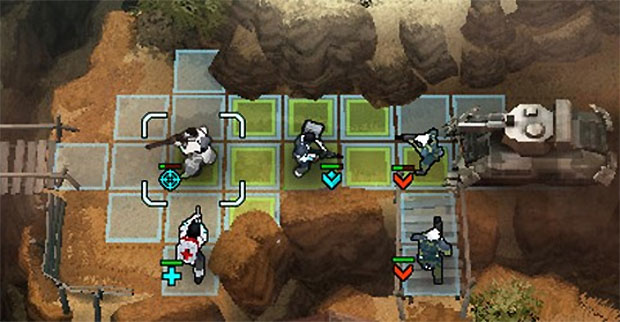
RPS: But you were still out there, it was just that no one thought to talk to you?
Julian Gollop: Other titles I did were some Chessmaster games, worked on a bunch of games which were cancelled, worked for a year on Assassin’s Creed: Liberation on the PS Vita, before leaving again to take a break.
RPS: Was there a sense when, during all this time, something had gone wrong or was it more a matter of you were just personally casting about, not sure what to do?
Julian Gollop: Well I think I was still pretty sure what I wanted to do, which was my own design of strategy games. I guess it was finding the means and opportunity to do it, the right time and the right place. When I first heard of Kickstarter funding of games I though that this would be an ideal mechanism, but it actually took me a long time to really decide to leave Ubisoft and do my own thing.
RPS: It’s a hell of a gamble I guess.
Julian Gollop: Yes it is, especially as I had two young kids of course. So I needed a bit of help with it, so that’s when I spoke with my business partner David Kaye, so he runs Gaming Insiders Network, which you may have heard of, which is mainly focused on mobile developers and web developers and so on. He was a big fan of my early games and X-COM and stuff so he helped me set up the company and get the stuff organised on the US side for Kickstarter. That was a good encouragement for me to also get going on the Kickstarter and get moving with development, so that was very helpful.

RPS: How’s it felt over the years when X-COM particularly has got namedropped as the best thing ever, but your career hadn’t necessarily led you to the highest profile things?
Julian Gollop: Languishing in obscurity (laughs). Put it this way: I intend to change that so we’ll see what happens. How do I feel about it? Well I guess I’m still quite proud that XCOM has retained that level of interest, and it’s also very good that Firaxis did a pretty good remake of it because that’s also in some ways made it easier for me to talk about my earlier stuff as well, because again the XCOM name is well-known and automatically sparks some interest, so you can say it is still helpful (laughs).
RPS: From this side of things, it seems it very much put your name back on the table whereas if it had been The Bureau, the other XCOM game, that probably wouldn’t have happened.
Julian Gollop: No, it could have turned out very differently.
RPS: Was there a sense that your own fortunes have altered because of the Firaxis game?
Julian Gollop: Not really but it has helped. It’s helped to establish turn-based strategy games as something that can actually be successful and popular.
RPS: Yeah, that’s huge, it’s made turn-based strategy games almost cool in a way.
Julian Gollop: And there’ve been quite a few that have come out in the last year that have been pretty good as well, and I think there’s nothing as big as XCOM, but there are attempts to cater for this demographic, if you want to call it that.
RPS: I find myself using the phrase ‘XCOM-like’ in stories on the site about some new indie thing… [It’s like] hang on, this wasn’t even a concept until 2 years ago. Incredible.
Julian Gollop: Exactly, and now you see games like Mordheim, which is one that stands out recently, which has come out in Early Access.
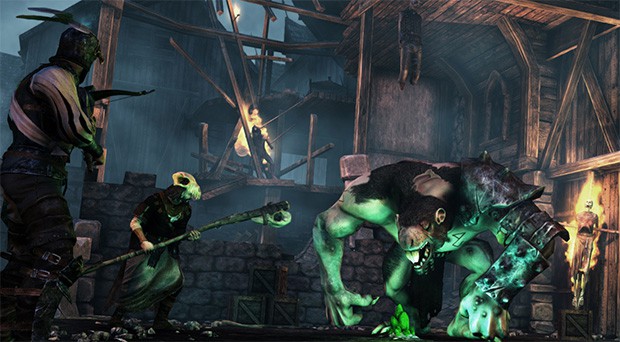
RPS: Invisible Inc is worth checking out.
Julian Gollop: Yes, I’ve played that a bit. There’s Warmachine Tactics which has also come out on Early Access.
RPS: And Massive Chalice.
Julian Gollop: Yes, the tactical RPG genre which is making its way, which was a heavily console-orientated genre but is coming into PCs a bit more distinctly.
RPS: Abstractly all of these are your children…
Julian Gollop: Maybe. It proves at least that there is a lot of interest in this style of game out there, if they’re done well. If they’ve got a reasonably good backing and good development team behind them and are reasonably well-funded, then you can produce something which is commercially viable and has got an audience. And there are some really big strategy games which have come out which have been very interesting, from Age of Wonders 3 to Endless Legend. Endless Legend, although it has some very typical 4X tropes in it, it’s quite distinctive and innovative in its own way, so there’s a lot of good stuff there I think, which is high quality coming out.
RPS: Yeah, it’s all just coming back to life, which is wonderful.
Julian Gollop: Steam Early Access helps this process of diversity and I think players now have got far more choice of good quality games of vastly diverse genres and experiences than they’ve ever had before, to be honest.

RPS: It’s just finding the right ones that’s become the trouble.
Julian Gollop: Yeah. It’s good for players at the moment, not so easy for developers, because you’re competing for attention from thousands of others, it makes it much much more difficult.
RPS: And I guess you’ve got to run the promotional gauntlet one extra time – you’ve already had to do it with Kickstarter, you’ll have to do it with release and now there’s this as well.
Julian Gollop: Yeah, and the Early Access release requires a lot more effort to get the game at least noticed and get attention. I think the process forces us to focus very much on what we’re adding to the game as we’re going along. The big mistake with Early Access is to release games which don’t have much gameplay value in them, so our approach has been, although we don’t have a huge amount of feaures in the game at the moment, is to make sure that what we’ve got really works very very well, and demonstrates that the game has that extendability, that it could be extended in terms of adding more content and stuff.
I think we kind of benefit also that our game has a lot of replayability to it. It’s not like an adventure game where you’ve got a fixed story that you play from beginning to end. I think Early Access is probably better for this kind of game, strategy games or games that have a degree of procedural generation or user generated content. That does seem to be a bit of a trend, multiplayer games too are better with Early Access games. I’m confident that we’re on the right path. Our next major thing that we’re going to air will be some AI modes, so we’ll have offline AI, online AI, so you’ll be able to play multi-player with AI, and this will be our next major update in the game which will be coming soon.
RPS: That’ll be handy especially as I didn’t have too much luck rounding up people to play against me right now.
Julian Gollop: No, it’s the big problem at the moment. I think especially with trying to do press previews you need to organise a game against somebody. It’ll be much easier once we have the AI system up and running.
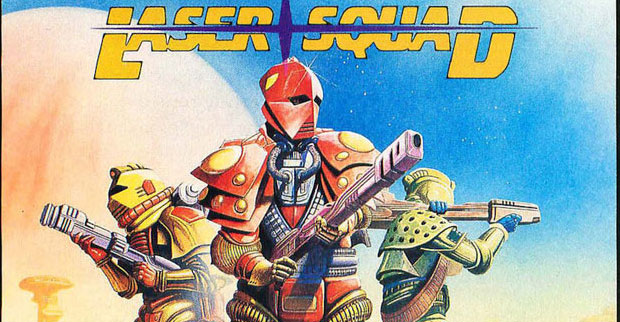
RPS: Was this comeback game always going to be Chaos or were you tossing up between doing that or Laser Squad?
Julian Gollop: Yeah, it was a toss up between this and Laser Squad. And I did work on a new design for the Laser Squad game but it was a bit more ambitious than Chaos. Also I still have a degree of fondness for the original Chaos, which I think it needed… I’d explored the Laser Squad style game quite a lot, but not so much the Chaos style game, so I think it really deserved to be made.
RPS: And indeed no one else had looked at it either.
Julian Gollop: Not really, no, and I mean there aren’t that many turn-based wizard combat games out there.
RPS: Was there any temptation to be quite cheeky yourself and make a spiritual XCOM sequel or at least a Kickstarter that was that, because it could have been the easy money?
Julian Gollop: Yes, I seriously considered that before Firaxis announced their XCOM, but of course once they announced it I thought well it’d be a hopeless cause because it’s just not going to get the same traction. I may have been completely wrong in thinking this by the way but (laughs).
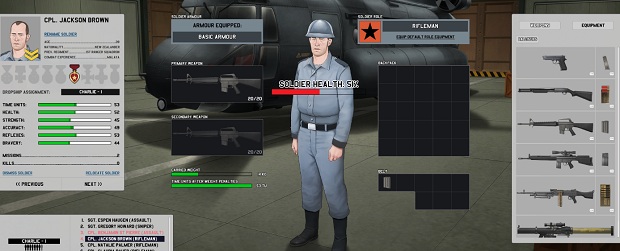
RPS: Well you never know, given Xenonauts did alright…
Julian Gollop: I certainly wouldn’t have done it the same way that Xenonauts did it, but I think the Firaxis XCOM would take a lot of beating I think, to make an XCOM that is better quality than that. It’s not that I would have done things the same way they did it, I certainly would have done things somewhat differently, because although you had some interesting strategies to pursue and so on, it did feel like you were being constrained along certain paths, rather than have a more open random game, which is what the original XCOM was.
RPS: It’s much more about refining an approach game after game as opposed to reacting to a situation that is very hard to predict. Even though I’ve played it loads I’m aware that I’m doing the same thing each time, especially in the first turn. I’ve got a play that I’m going to endorse time after time.
Julian Gollop: I did think of doing something up until the Firaxis announcement, but after that I realised I had to abandon hopes of resurrecting an XCOM style game.
RPS: It’s not what you want to hear but I think you could have got away with it. And it’s not too late now. Whatever they do next will not be closer to what you would have done.
Julian Gollop: I probably could have. I don’t know.

RPS: I hope it doesn’t sting too much anyway. There’s definitely room for a third route between what Xenonauts did and what The Long War mod is doing and then what Firaxis did. I’d quite like to see that certainly.
Julian Gollop: Well, we’ll see. Got to finish Chaos first.
RPS: Thanks for your time.
Chaos Reborn is out on Early Access now.
Disclaimer: I backed Chaos Reborn on Kickstarter, because I wanted to play it.







